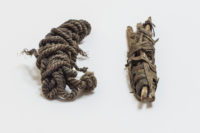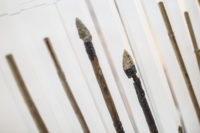 Ötzi the Iceman, the 5,300-year-old Neolithic glacier mummy discovered by hikers in the Otztal Alps in 1991, has set another record: he is the owner of the oldest known bowstring in the world. In fact, Ötzi’s whole kit — quiver, arrows, bowstring and unfinished bow — is the oldest hunting equipment in the world.
Ötzi the Iceman, the 5,300-year-old Neolithic glacier mummy discovered by hikers in the Otztal Alps in 1991, has set another record: he is the owner of the oldest known bowstring in the world. In fact, Ötzi’s whole kit — quiver, arrows, bowstring and unfinished bow — is the oldest hunting equipment in the world.
Made of three strands of twisted fibers, the cord was found in the quiver. The Iceman had carefully wound it into an S-shaped bundle and tied a knot at the end, not unlike how I store my extension cords. It looks like a hemp rope and experts at the South Tyrol Museum of Archeology where Ötzi and his stuff are kept were not able to determine whether the cord was made of plant or animal fiber. The former would be unusable for a bowstring because they lack the necessary flexibility to withstand the tension of the bow.
Only three examples of Neolithic bowstrings are known to have survived. A study by the Swiss National Science Foundation (SNSF) compared prehistoric bowstrings recovered from alpine glaciers. Using a microscopic fiber sample from the string found in Ötzi’s quiver, the team confirmed that it was made of the leg sinew of an undetermined animal, not from plant fibers, and therefore ideally suited for a bowstring. The cord is almost six-and-a-half feet long, long enough to fit the 5’11”-long yew stave Ötzi had  almost finished fashioning into a bow when he was killed. Stretched out to its full taunt length, the cord, which is 4mm in diameter relaxed, would be 2-3mm in diameter, a perfect fit for the width of the notches in the arrows Ötzi carried. A loosely wound bundle of animal leg sinew was also found in his quiver, perhaps raw material for bowstring production.
almost finished fashioning into a bow when he was killed. Stretched out to its full taunt length, the cord, which is 4mm in diameter relaxed, would be 2-3mm in diameter, a perfect fit for the width of the notches in the arrows Ötzi carried. A loosely wound bundle of animal leg sinew was also found in his quiver, perhaps raw material for bowstring production.
The rest of Ötzi’s gear also lends unique insight into Neolithic hunting practices, touching on a range of subjects from trade to tool use to the kinesiology of the hunt.
Ötzi’s 1.83 m long, unfinished bow made of yew (Taxus baccata) gave a unique, informative glimpse into how Neolithic bows were manufactured. The bow was first freshly cut from an 8-10 cm thick yew tree. He had already made good progress with his work, but the bow probably needed to be shortened and thinned. The best shooting results are obtained when the bow approximately corresponds to the height of the archer. For Ötzi that would have been approximately 1.60m. The investigation was able to establish that Ötzi’s bow had been worked with a hatchet from both directions. Whether this had been done by Ötzi himself cannot be determined. The question of how to work the ends of the bow to fasten the string also remains open. Junkmanns proposed the hypothesis that Ötzi could have purchased the rough bow on the way, which would possibly explain why he had an unfinished bow with him in the high mountains.
Even the Iceman’s quiver is the only known Neolithic carrying case for arrows. It is 86 cm long and stitched from doeskin (Rupicapra rupicapra). One side of the quiver is reinforced with a hazel wood stick. At the upper end of the quiver a flap of stiffened leather protected the arrows carried within. If required, it could be opened very quickly and an arrow could be pulled out with a single motion of the arm.
The quiver’s interior held 14 arrows, two of which were ready to fire and complete with arrowheads and fletching. They represent the best preserved examples of Neolithic arrow production in Europe. Neolithic arrows were most often made from branches of suitable bushes like hazel (Corylus avellana) or, as with Ötzi, from the branches of the wayfaring tree (Viburnum lantana). Three feather halves were attached to the end of Ötzi’s arrows with birch tar glue and bound with thin nettle fibers. They represent the only preserved fletchings in Europe. The three-part, radially-placed fletching for stabilizing the arrow during flight has remained virtually unchanged since the Neolithic.
The SNSF study has been published in the Journal of Neolithic Archaeology and can be read here.
